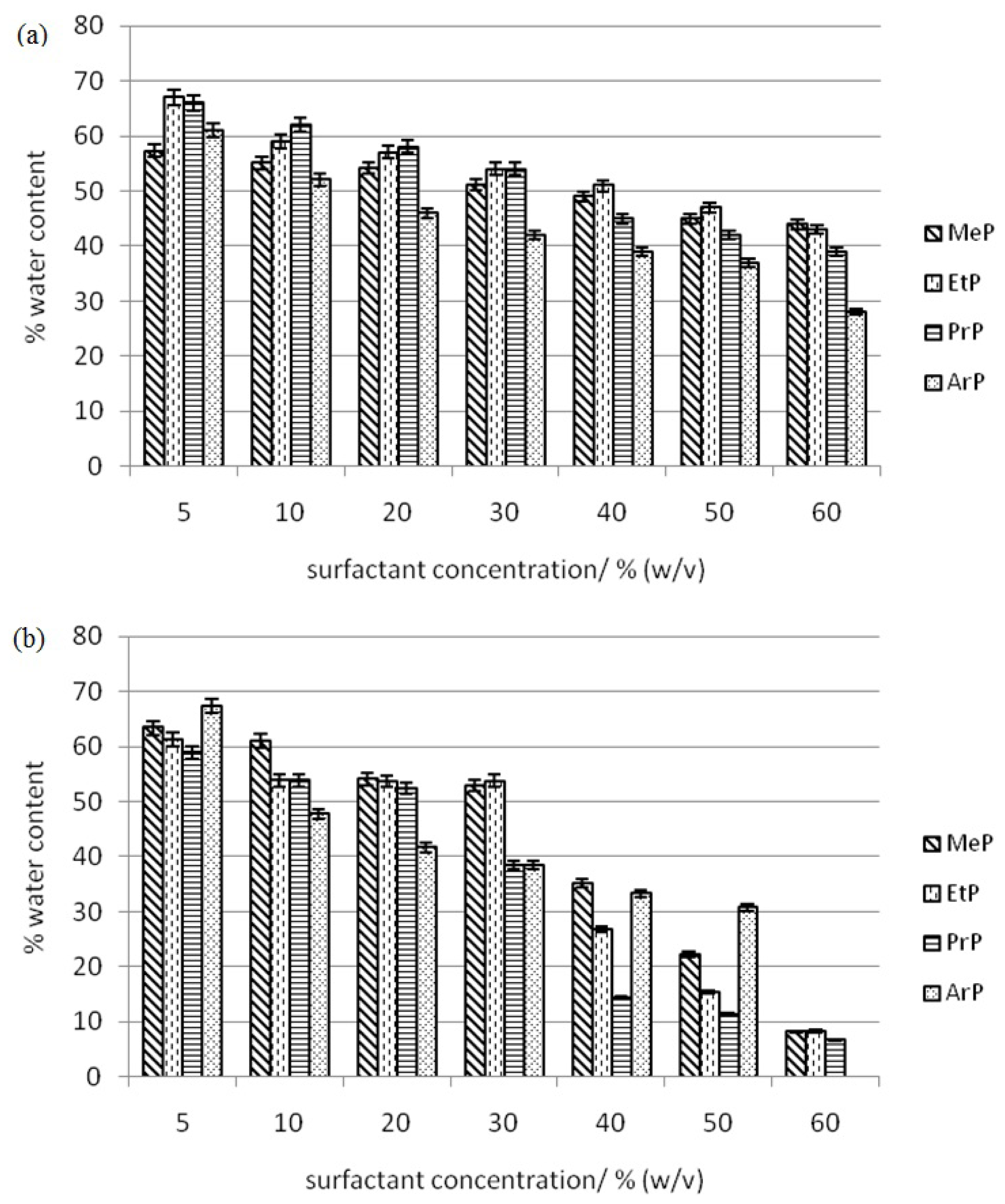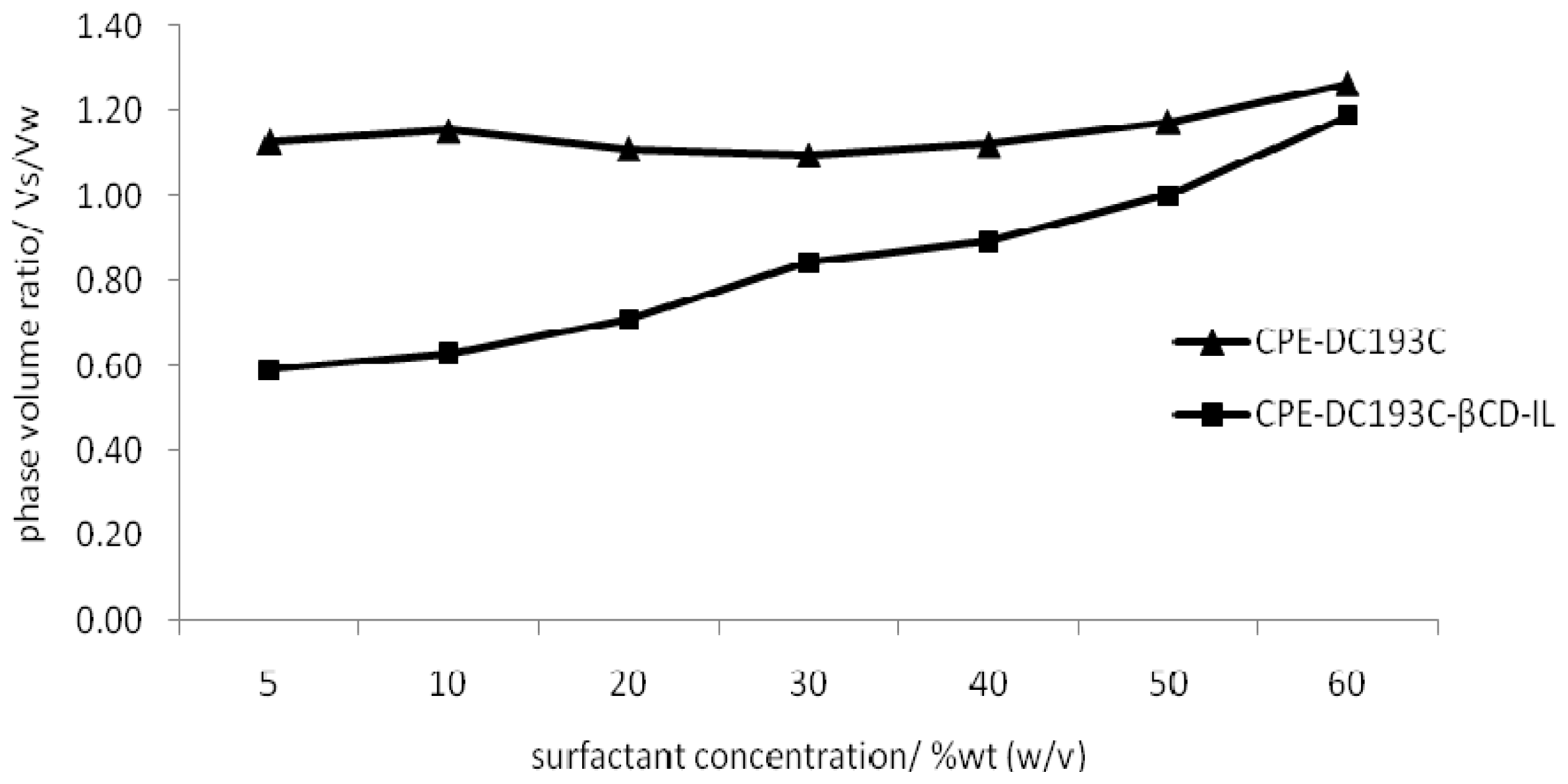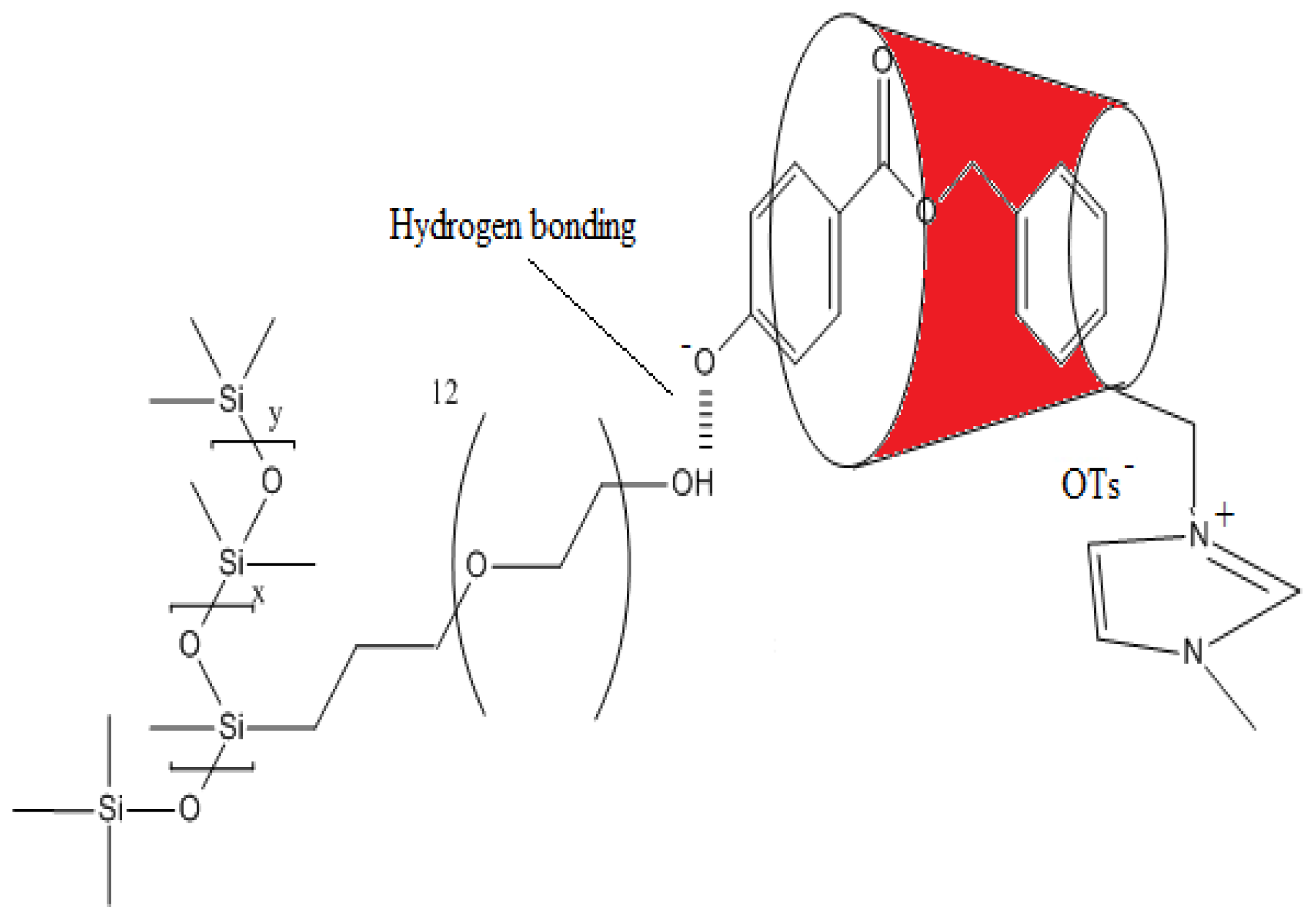Cloud Point Extraction of Parabens Using Non-Ionic Surfactant with Cylodextrin Functionalized Ionic Liquid as a Modifier
Abstract
:1. Introduction
2. Results and Discussion
2.1. Effect of pH on Extraction Recoveries of Parabens Extraction
2.2. Water Content in Surfactant-Rich Phase
2.3. Distribution Coefficient
2.4. Phase Volume Ratio and Preconcentration Factor
2.5. Method Validation
2.6. Extraction Behavior of ArP and DC193C with βCD-IL
3. Experimental Section
3.1. Reagents and Standards
3.2. Instrumentation
3.3. Synthesis β-Cyclodextrin Functionalized Ionic Liquid (βCD-IL) (1)
3.4. Preparation for Cloud Point Extraction (CPE)
3.5. Analysis of Water Samples
3.6. Preparation and Characterization of Inclusion Complex of βCD-IL, Surfactant DC193C and Benzyl Paraben
4. Conclusions
Supplementary Information
ijms-14-24531-s001.pdfAcknowledgments
Conflicts of Interest
References
- Darbre, P.D.; Harvey, P.W. Paraben esters: Review of recent studies of endocrine toxicity, absorption, esterase and human exposure, and discussion of potential human health risks. J. Appl. Toxicol 2008, 28, 561–578. [Google Scholar]
- Khanna, S.; Darbre, P.D. Parabens enable suspension growth of MCF-10A immortalized, non-transformed human breast epithelial cells. J. Appl. Toxicol 2012, 33, 378–382. [Google Scholar]
- Ramírez, N.; Marcé, R.M.; Borrull, F. Determination of parabens in house dust by pressurised hot water extraction followed by stir bar sorptive extraction and thermal desorption–gas chromatography-mass spectrometry. J. Chromatogr. A 2011, 1218, 6226–6231. [Google Scholar]
- Barr, L.; Metaxas, G.; Harbach, C.; Savoy, L.; Darbre, P. Measurement of paraben concentrations in human breast tissue at serial locations across the breast from axilla to sternum. J. Appl. Toxicol 2012, 32, 219–232. [Google Scholar]
- Wang, S.-P.; Chang, L.-C. Determination of parabens in cosmetic products by supercritical fluid extraction and capillary zone electrophoresis. Anal. Chim. Acta 1998, 377, 85–93. [Google Scholar]
- Lokhnauth, J.K.; Snow, N.H. Determination of parabens in pharmaceutical formulations by solid-phase microextraction ion mobility spectrometry. Anal. Chem 2005, 77, 5938–5946. [Google Scholar]
- Tang, T.; Qian, K.; Shi, T.; Wang, F.; Li, J.; Cao, Y. Determination of triazole fungicides in environmental water samples by high performance liquid chromatography with cloud point extraction using polyethylene glycol 600 monooleate. Anal. Chim. Acta 2010, 680, 26–31. [Google Scholar]
- Man, B.K.W.; Lam, M.H.W.; Lam, P.K.S.; Wu, R.S.S.; Shaw, G. Cloud-point extraction and preconcentration of cyanobacterial toxins (microcystins) from natural waters using a cationic surfactant. Environ. Sci. Technol 2002, 36, 3985–3990. [Google Scholar]
- Kiran, K.; Kumar, K.S.; Prasad, B.; Suvardhan, K.; Lekkala, R.B.; Janardhanam, K. Speciation determination of chromium (III) and (VI) using preconcentration cloud point extraction with flame atomic absorption spectrometry (FAAS). J. Hazard. Mater 2008, 150, 582–586. [Google Scholar]
- Meeravali, N.N.; Jiang, S.-J. A novel cloud point extraction approach using cationic surfactant for the separation and pre-concentration of chromium species in natural water prior to ICP-DRC-MS determination. Talanta 2009, 80, 173–178. [Google Scholar]
- Bai, D.; Li, J.; Chen, S.; Chen, B.-H. A novel cloud-point extraction process for preconcentrating selected polycyclic aromatic hydrocarbons in aqueous solution. Environ. Sci. Technol 2001, 35, 3936–3940. [Google Scholar]
- Baig, J.A.; Kazi, T.G.; Shah, A.Q.; Arain, M.B.; Afridi, H.I.; Khan, S.; Kandhro, G.A.; Soomro, A.S. Evaluating the accumulation of arsenic in maize (Zea mays L.) plants from its growing media by cloud point extraction. Food Chem. Toxicol 2010, 48, 3051–3057. [Google Scholar]
- Fontana, A.R.; Silva, M.F.; Martínez, L.D.; Wuilloud, R.G.; Altamirano, J.C. Determination of polybrominated diphenyl ethers in water and soil samples by cloud point extraction-ultrasound-assisted back-extraction-gas chromatography–mass spectrometry. J. Chromatogr. A 2009, 1216, 4339–4346. [Google Scholar]
- Khan, S.; Kazi, T.G.; Baig, J.A.; Kolachi, N.F.; Afridi, H.I.; Wadhwa, S.K.; Shah, A.Q.; Kandhro, G.A.; Shah, F. Cloud point extraction of vanadium in pharmaceutical formulations, dialysate and parenteral solutions using 8-hydroxyquinoline and nonionic surfactant. J. Hazard. Mater 2010, 182, 371–376. [Google Scholar]
- Liang, P.; Yang, J. Cloud point extraction preconcentration and spectrophotometric determination of copper in food and water samples using amino acid as the complexing agent. J. Food Compos. Anal 2010, 23, 95–99. [Google Scholar]
- Silva, E.L.; Roldan, P.D.S.; Giné, M.F. Simultaneous preconcentration of copper, zinc, cadmium, and nickel in water samples by cloud point extraction using 4-(2-pyridylazo)-resorcinol and their determination by inductively coupled plasma optic emission spectrometry. J. Hazard. Mater 2009, 171, 1133–1138. [Google Scholar]
- Sun, Z.Y.; Shen, M.X.; Cao, G.P.; Deng, J.; Liu, Y.; Liu, T.; Zhao, L.; Yuan, W.K. Preparation of bimodal porous copolymer containing β-cyclodextrin and its inclusion adsorption behavior. J. Appl. Polym. Sci 2010, 118, 2176–2185. [Google Scholar]
- Mohamad, S.; Surikumaran, H.; Raoov, M.; Marimuthu, T.; Chandrasekaram, K.; Subramaniam, P. Conventional study on novel dicationic ionic liquid inclusion with β-cyclodextrin. Int. J. Mol. Sci 2011, 12, 6329–6345. [Google Scholar]
- Mohamad, S.; Kamal, S. Study on inclusion complex of beta-cyclodextrin-dithizone-zinc (beta-CD-H (2) Dz-Zn) by spectrophotometry and its analytical application. Asian J. Chem 2013, 25, 1965–1969. [Google Scholar]
- Sambasevam, K.P.; Mohamad, S.; Sarih, N.M.; Ismail, N.A. Synthesis and characterization of the inclusion complex of β-cyclodextrin and azomethine. Int. J. Mol. Sci 2013, 14, 3671–3682. [Google Scholar]
- Zhang, J.; Shen, X.; Chen, Q. Separation processes in the presence of cyclodextrins using molecular imprinting technology and ionic liquid cooperating approach. Curr. Org. Chem 2011, 15, 74–85. [Google Scholar]
- Crini, G. Kinetic and equilibrium studies on the removal of cationic dyes from aqueous solution by adsorption onto a cyclodextrin polymer. Dyes Pigments 2008, 77, 415–426. [Google Scholar]
- Chin, Y.P.; Mohamad, S.; Abas, M.R.B. Removal of parabens from aqueous solution using β-cyclodextrin cross-linked polymer. Int. J. Mol. Sci 2010, 11, 3459–3471. [Google Scholar]
- Mohamad, S.; Yusof, N.H.M.; Asman, S. Effect of bifunctional isocyanate linker on adsorption of chromium (VI) diphenylcarbazide complex onto beta-cyclodextrin. Asian J. Chem 2013, 25, 2213–2220. [Google Scholar]
- Liu, H.; Cai, X.; Wang, Y.; Chen, J. Adsorption mechanism-based screening of cyclodextrin polymers for adsorption and separation of pesticides from water. Water Res 2011, 45, 3499–3511. [Google Scholar]
- López-de-Dicastillo, C.; Gallur, M.; Catalá, R.; Gavara, R.; Hernandez-Muñoz, P. Immobilization of β-cyclodextrin in ethylene-vinyl alcohol copolymer for active food packaging applications. J. Membr. Sci 2010, 353, 184–191. [Google Scholar] [Green Version]
- Qian, L.; Guan, Y.; Xiao, H. Preparation and characterization of inclusion complexes of a cationic β-cyclodextrin polymer with butylparaben or triclosan. Int. J. Pharm 2008, 357, 244–251. [Google Scholar]
- Subramaniam, P.; Mohamad, S.; Alias, Y. Synthesis and characterization of the inclusion complex of dicationic ionic liquid and β-cyclodextrin. Int. J. Mol. Sci 2010, 11, 3675–3685. [Google Scholar]
- McEwen, A.B.; Ngo, H.L.; LeCompte, K.; Goldman, J.L. Electrochemical properties of imidazolium salt electrolytes for electrochemical capacitor applications. J. Electrochem. Soc 1999, 146, 1687–1695. [Google Scholar]
- Rahim, N.Y.; Mohamad, S.; Alias, Y.; Sarih, N.M. Extraction behavior of Cu(II) ion from chloride medium to the hydrophobic ionic liquidss using 1,10-phenantroline. Separ. Sci. Technol 2012, 47, 250–255. [Google Scholar]
- Mecerreyes, D. Polymeric ionic liquids: Broadening the properties and applications of polyelectrolytes. Prog. Polym. Sci 2011, 36, 1629–1648. [Google Scholar]
- Ong, T.T.; Tang, W.; Muderawan, W.; Ng, S.C.; Chan, H.S. Synthesis and application of single-isomer 6-mono(alkylimidazolium)-beta-cyclodextrins as chiral selectors in chiral capillary electrophoresis. Electrophoresis 2005, 20, 3839–3848. [Google Scholar]
- Wang, R.-Q.; Ong, T.-T.; Ng, S.-C. Synthesis of cationic β-cyclodextrin derivatives and their applications as chiral stationary phases for high-performance liquid chromatography and supercritical fluid chromatography. J. Chromatogr. A 2008, 1203, 185–192. [Google Scholar]
- Ong, T.-T.; Wang, R.-Q.; Muderawan, I.W.; Ng, S.-C. Synthesis and application of mono-6-(3-methylimidazolium)-6-deoxyperphenylcarbamoyl-β-cyclodextrin chloride as chiral stationary phases for high-performance liquid chromatography and supercritical fluid chromatography. J. Chromatogr. A 2008, 1182, 136–140. [Google Scholar]
- Zhou, Z.; Li, X.; Chen, X.; Hao, X. Synthesis of ionic liquids functionalized β-cyclodextrin-bonded chiral stationary phases and their applications in high-performance liquid chromatography. Anal. Chim. Acta 2010, 678, 208–214. [Google Scholar]
- Paleologos, E.K. Cationic surfactant-based polyfluorate salts: Phase separation and analytical applications in the extraction and preconcentration of ionic species prior to liquid chromatography. J. Chromatogr. A 2005, 1066, 19–25. [Google Scholar]
- Sadeghi, R.; Ebrahimi, N.; Mahdavi, A. Thermodynamic studies of the ionic liquid 1-hexyl-3-methylimidazolium chloride [C6mim][Cl] in polyethylene glycol aqueous solutions. J. Chem. Thermodyn 2012, 47, 48–55. [Google Scholar]
- Yao, B.; Yang, L.; Hu, Q.; Shigendo, A. Cloud point extraction of polycyclic aromatic hydrocarbons in aqueous solution with silicone surfactants. Chin. J. Chem. Eng 2007, 15, 468–473. [Google Scholar]
- Li, J.-L.; Chen, B.-H. Equilibrium partition of polycyclic aromatic hydrocarbons in a cloud-point extraction process. J. Colloid. Interf. Sci 2003, 263, 625–632. [Google Scholar]
- Neuhaus, D.; Williamson, M.P. The Nuclear Overhauser Effect in Structural and Conformational Analysis, 2nd ed; John Wiley & Sons: New York, NY, USA, 2000. [Google Scholar]
- Sanders, J.K.M.; Hunter, B.K. Modern NMR Spectroscopy: A Guide for Chemists, 2nd ed; Oxford University Press: Oxford, UK, 1993. [Google Scholar]
- Li, J.; Ni, X.; Zhou, Z.; Leong, K.W. Preparation and characterization of polypseudorotaxanes based on block-selected inclusion complexation between poly (propylene oxide)-poly(ethylene oxide)-poly(propylene oxide) triblock copolymers and α-cyclodextrin. J. Am. Chem. Soc 2003, 125, 1788–1795. [Google Scholar]
- Zhong, N.; Byun, H.-S.; Bittman, R. An improved synthesis of 6-O-monotosyl-6-deoxy-β-cyclodextrin. Tetrahedron. Lett 1998, 39, 2919–2920. [Google Scholar]
- Cwiertnia, B.; Hladon, T.; Stobiecki, M. Stability of diclofenac sodium in the inclusion complex with β-cyclodextrin in the solid state. J. Pharm. Pharmacol 1999, 51, 1213–1218. [Google Scholar]






| Log Kd | CPE-DC193C | CPE-DC193C-βCD-IL |
|---|---|---|
| MeP | 1 | 3.2 |
| EtP | 2.6 | 3.6 |
| PrP | 3.2 | 4.6 |
| ArP | 3.8 | 4.9 |
| Analyte | Precison, coefficient of determination and limit of detection | CPE-DC193C | CPE-DC193C-βCD-IL |
|---|---|---|---|
| MeP | RSD (% n = 3) | 0.17 | 0.28 |
| Coefficient of determination, R2 | 0.998 | 0.990 | |
| LOD (μg mL−1) | 0.29 | 0.038 | |
| EtP | RSD (% n = 3) | 0.45 | 0.86 |
| Coefficient of determination, R2 | 0.991 | 0.991 | |
| LOD (μg mL−1) | 0.23 | 0.026 | |
| PrP | RSD (% n = 3) | 0.66 | 0.36 |
| Coefficient of determination, R2 | 0.986 | 0.993 | |
| LOD (μg mL−1) | 0.21 | 0.016 | |
| ArP | RSD (% n = 3) | 0.47 | 0.13 |
| Coefficient of determination, R2 | 0.993 | 0.991 | |
| LOD (μg mL−1) | 0.14 | 0.013 | |
| Method | Analyte | River water recovery, % RSD, % | Tap water recovery, % RSD, % | Treated water recovery, % RSD, % | Sea water recovery, % RSD, % |
|---|---|---|---|---|---|
| CPE-DC193C | MeP | 96.2 (0.47) | 83.8 (0.59) | 85.9(0.2) | 72.1 (0.62) |
| EtP | 93.8 (0.15) | 96.3 (0.76) | 87.7(0.30) | 71.2 (0.55) | |
| PrP | 97.7 (0.63) | 93.3 (0.26) | 94.3(0.40) | 87.9 (0.23) | |
| ArP | 89.5 (0.29) | 80.6 (0.67) | 85.6(0.34) | 85.8 (0.40) | |
| CPE-DC193C-DC193C-βCD-IL | MeP | 97.5 (0.35) | 92.3 (0.26) | 97.8 (0.22) | 96.2 (0.32) |
| EtP | 98.9 (0.80) | 94.9 (0.83) | 92.9 (0.96) | 91.2 (0.72) | |
| PrP | 97.4 (0.15) | 97.8 (0.42) | 96.1 (0.48) | 93.2 (0.64) | |
| ArP | 97.6 (0.63) | 95.5(0.34) | 100.0 (0.49) | 98.2 (0.68) | |
| Proton | βCD-IL | ArP | βCD-IL-ArP-DC193C | |
|---|---|---|---|---|
| § | § | § | Δ§ | |
| H1 | 4.8191 | 4.8315 | +0.0124 | |
| H2 | 3.3119 | 3.3445 | +0.0326 | |
| H3 | 3.5987 | 3.5483 | −0.0504 | |
| H4 | 3.3656 | 3.3945 | +0.0289 | |
| H5 | 3.5517 | 3.4848 | −0.0669 | |
| H6 | 3.6176 | 3.6331 | +0.0155 | |
| H8 | 7.4545 | 7.4847 | +0.0302 | |
| H9 | 7.0939 | 7.1057 | +0.0118 | |
| H11 | 2.0677 | 2.0594 | −0.0083 | |
| Ha | 2.2752 | 2.2760 | +0.0008 | |
| Hb | 9.0063 | 8.9827 | −0.0236 | |
| Hc | 7.6730 | 7.6586 | −0.0144 | |
| Hd | 7.9300 | 7.9500 | +0.0200 | |
| Ha-p | 7.4200 | 7.4023 | −0.0177 | |
| Hb-p | 7.3770 | 7.3669 | −0.0101 | |
| Hc-p | 7.3370 | 7.3272 | −0.0098 | |
| Hd-p | 5.2780 | 5.2623 | −0.0157 | |
| He-p | 7.8530 | 7.8154 | −0.0376 | |
| Hf-p | 6.8730 | 6.8256 | −0.0474 | |
| Proton | DC193C | βCD-IL-ArP-DC193C | ||
| § | § | Δ§ | ||
| Ha-s | 0.4320 | 0.4314 | −0.0006 | |
| Hb-s | 0.0305 | 0.0001 | −0.0304 | |
| Hc-s | 0.8262 | 0.7951 | −0.0238 | |
| Hd-s | 1.4401 | 1.4795 | −0.0384 | |
| He-s | 3.3780 | 3.2938 | −0.0842 | |
| Hf-s | 3.5257 | 3.4848 | −0.0414 | |
| Hg-s | 3.4037 | 3.3945 | −0.0092 | |
© 2013 by the authors; licensee MDPI, Basel, Switzerland This article is an open access article distributed under the terms and conditions of the Creative Commons Attribution license (http://creativecommons.org/licenses/by/3.0/).
Share and Cite
Noorashikin, M.S.; Raoov, M.; Mohamad, S.; Abas, M.R. Cloud Point Extraction of Parabens Using Non-Ionic Surfactant with Cylodextrin Functionalized Ionic Liquid as a Modifier. Int. J. Mol. Sci. 2013, 14, 24531-24548. https://0-doi-org.brum.beds.ac.uk/10.3390/ijms141224531
Noorashikin MS, Raoov M, Mohamad S, Abas MR. Cloud Point Extraction of Parabens Using Non-Ionic Surfactant with Cylodextrin Functionalized Ionic Liquid as a Modifier. International Journal of Molecular Sciences. 2013; 14(12):24531-24548. https://0-doi-org.brum.beds.ac.uk/10.3390/ijms141224531
Chicago/Turabian StyleNoorashikin, Md Saleh, Muggundha Raoov, Sharifah Mohamad, and Mhd Radzi Abas. 2013. "Cloud Point Extraction of Parabens Using Non-Ionic Surfactant with Cylodextrin Functionalized Ionic Liquid as a Modifier" International Journal of Molecular Sciences 14, no. 12: 24531-24548. https://0-doi-org.brum.beds.ac.uk/10.3390/ijms141224531




